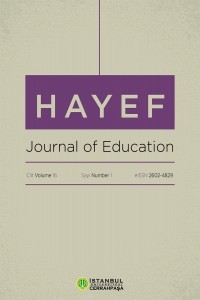ANLATISAL DİZİLİMLERİN ÖĞRETİMİNE YÖNELİK EYLEM ODAKLI BİR SINIF ETKİNLİĞİ ÖNERİSİ
Çeşitli söylem türlerini yansıtan metinlerin yabancı dil öğretiminde eğitsel içerik olarak kullanımı, günümüzde geçerliliğini korumaktadır. Bir dilin ekinsel ve sözcüksel zenginliğini simgeleyen metinler, sözlü ve yazılı belgeler olarak dilsel işleyişin farklı boyutları bağlamında da önemli ipuçları sağlamaktadır. Bu açıdan bakıldığında, metinler yoluyla yabancı dil öğretimi, öğrenenlerin bildirişimsel-dilsel yetilerinin geliştirilmesi için önemlidir. Metinlerde en çok karşılaşılan söylem türlerinden biri olan anlatı öğesi, yalnızca yazın alanının tekelinde olmayıp haber amaçlı gazete yazıları ya da çeşitli amaçlarla hazırlanmış özet metinlerde de yer bulabilmektedir. Dolayısıyla, bu çalışmanın amacı, Adam’ın (1997/2011), bir metin çözümleme aracı olarak tasarladığı dizilimsel düzenleniş kavramını anlatısal bir metne uygulayarak bu uygulama üzerine eylem odaklı bir sınıf etkinliği geliştirmektir. Öncelikle, kuramsal bölümde, metin çözümlemenin dizilimsel boyutu incelenmiş; Eylem Odaklı Yaklaşım’a kısaca değinilmiştir. Ardından, uygulama bölümünde, yabancı dil olarak Fransızca öğretiminde kullanılan Rond-Point 3 adlı yöntem kitabındaki Buzdağı adlı film özetine dizilimsel düzenleniş yaklaşımı uygulanmış; bu uygulamadan yola çıkarak da B2 dil düzeyinde temel dil becerilerinin geliştirilmesine yönelik eylem odaklı bir sınıf etkinliği önerilmiştir. Etkinlik oluşturulurken kuramsal kaynakların yanı sıra, konuyla ilgili iki atölye çalışması da dikkate alınmıştır
Anahtar Kelimeler:
Anlatısal Metin Çözümlemesi, Dizilimsel Düzenleniş, Eylem Odaklı Yaklaşım, Sınıf Etkinlikleri, B2 Dil Düzeyi
-
The use of texts, as pedagogical content, reflecting various discursive types actually maintains its valid status in the teaching of foreign languages. Representing the cultural and the lexical richness of a language, texts, as oral and written documents, give us clues concerning the different dimensions of the linguistic functioning as well. In that context, the teaching of foreign languages through texts proves to be essential in order to develop the communicative-linguistic competences of learners. As one of the most frequent discursive types, narration is not the sole appanage of the field of literature; i.e. it also manifests itself via news in newspapers or summary texts written for various purposes. Thus, the present paper aims to apply Adam’s (1997/2011) sequential organization concept designed as a textual analysis tool to a narrative text and to elaborate an action-oriented classroom activity deriving from the implementation. Firstly, in the theoretical section, the sequential dimension of the textual analysis was examined, and the Action-Oriented Approach was briefly mentioned. Then, the above-mentioned textual analysis tool was applied to the synopsis of a movie called L’Iceberg, featuring in the coursebook Rond-Point 3 used for the teaching of French as a foreign language; via this implementation, an action-oriented activity was proposed in order to develop basic language skills concerning the B2 language level. When creating the activity, two workshops involving the subject were also taken into account along with theoretical references
Keywords:
-,
___
- Adam, J.-M. (1976). Linguistique et discours littéraire. Paris : Librairie Larousse.
- Adam, J.-M. (1997). Les textes : types et prototypes. Paris : Éditions Nathan.
- Adam, J.-M. (2005). La linguistique textuelle : introduction à l’analyse textuelle. Paris : Armand Colin.
- Adam, J.-M. (2011). Les textes : types et prototypes. Paris : Armand Colin.
- Adam, J.-M. & Revaz, F. (1996). L’analyse des récits. Poitiers : Aubin.
- Albert, M.-C. & Souchon, M. (2000). Les textes littéraires en classe de langue. Paris : Hachette.
- Altet, M. (1994). La formation professionnelle des enseignants : analyse des pratiques et situations pédagogiques. Paris : PUF.
- Benveniste, E. (1974). Problèmes de linguistique générale (Tome 2). Paris : Éditions Gallimard.
- Bertocchini, P. & Costanzo, E. (2008). Manuel de formation pratique pour le professeur de FLE. Clamecy : CLÉ International.
- Capucho, F., Denyer, M., Labascoule, J. & Royer, C. (2007). Rond-Point 3. Difusión : Barcelone.
- Colette, S. (2011). Pour un enseignement actif du français (Atelier). Istanbul, Université d’Istanbul, 21 Avril 2011.
- Conseil de l’Europe (2005). Un cadre européen commun de référence pour les langues : apprendre, enseigner, évaluer. Paris : Les Éditions Didier.
- Courtés, J. (1991). Analyse sémiotique du discours. Paris : Hachette.
- Courtillon, J. (2003). Élaborer un cours de FLE. Paris : Hachette.
- Eco, U. (1985). Lectori in fabula (traduit par Myriem Bouzaher). Paris : Éditions Grasset.
- Emorine, M. (2011). Scénarisation d’une tâche/d’un projet : construction d’une séquence pédagogique dans une perspective actionnelle (Atelier). Istanbul, Université d’Istanbul, 4 Mai 2011.
- Germain, C. (1993). Évolution de l’enseignement des langues : 5000 ans d’histoire. Paris : CLE International.
- Greimas, A.-J. (1966). Sémantique structurale. Paris : Librairie Larousse.
- Maingueneau, D. (1994). L’énonciation en linguistique française. Paris : Hachette.
- Mucchielli, R. (2009). Le travail en équipe. Issy-les-Moulineaux : ESF.
- Papo, E. & Bourgain, D. (1989). Littérature et communication en classe de langue. Paris : Hatier.
- Peytard, J. (1982). Littérature et classe de langue. Paris : Hatier,
- Reboul, A. & Moeschler, J. (1998). Pragmatique du discours : de l’interprétation de l’énoncé à l’interprétation du discours. Paris : Armand Colin.
- Riegel, M., Pellat, J.-C. & Rioul, R. (2009). Grammaire méthodique du français. Paris : Presses Universitaires de France.
- Simonin-Grumbach, J. (1975). Pour une typologie des discours. Dans J. Kristeva, J.-C. Milner & N. Ruwet (Éds.), Langue, discours, société (pp. 85-121). Paris : Éditions du Seuil.
- Başlangıç: 2004
- Yayıncı: İstanbul Üniversitesi-Cerrahpaşa
Sayıdaki Diğer Makaleler
Murat ÇOBAN, Arif TOPUZ, Embiya ÇELİK, Selçuk KARAMAN
Nurcan ALBAYRAK DENGİZ, Defne YILMAZ
TÜRKİYE NÜFUSUNUN YAŞLANMA ENDEKSİ VE POTANSİYEL DESTEK ORANLARININ DAĞILIMI
FEN BİLİMLERİ ÖĞRETMENLERİNE GÖRE BAŞARILI ÖĞRENCİ
Murat GENÇ, Sedat KARAÇAM, Fatih AYDIN
Sezen CAMCI ERDOĞAN, Nihat Gürel KAHVECİ
BİYOLOJİ ÖĞRETMENİ ADAYLARININ ÜSTBİLİŞ FARKINDALIKLARININ FARKLI DEĞİŞKENLER AÇISINDAN İNCELENMESİ
Şeyda GÜL, Esra ÖZAY-KÖSE, Sibel SADİ YILMAZ
YABANCI DİL OLARAK FRANSIZCA ÖĞRETİMİNDE YAZINSAL METİN KULLANMA YAKLAŞIMI ÜZERİNE
